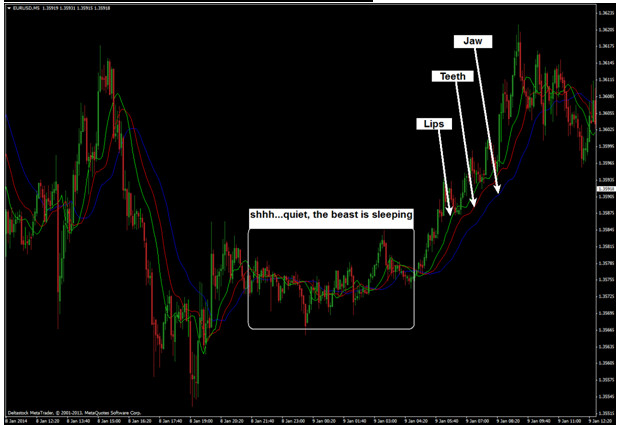Alligators and Trading? What is the Connection? Binary Options!
Review of the Alligator Tool for Binary Options Trading
We have Bears, Bulls… so why not an Alligator. The Bulls are buying, the Bears are selling and the Alligator eats them all… metaphorically speaking, of course. I know, you might be thinking that I lost it with all the metaphors and animals but fortunately that is not the case (I hope at least) and instead, I am talking about an indicator developed by Bill Williams. This tool helps the trader gauge the momentum of an asset and to identify trends if used on a higher time frame so let’s go into a bit more detail.
What is the Alligator indicator and how to use it?
The Alligator is available on the popular Meta Trader 4 platform and is composed of three moving averages which move together, indicating a ranging or trending market by contracting or expanding. These three moving averages are named Jaw (the default period is 13 and has a blue color), Teeth (default period is 8 and has a red color) and Lips (default period is 5, with a green color). When the three lines of the indicator are close together, it is said the Alligator is “sleeping” with its mouth closed and the market is quiet, moving sideways. But when the lines are starting to spread apart, the Alligator is waking up, opens its mouth and starts to eat… bulls and bears. Sorry, I didn’t come up with that metaphor by myself, but I hope you get the picture: moving averages close together – no action; moving averages spread apart – time to get a piece of the action. Have a look:

As you can see from the picture above, when the mouth of the alligator is closed (moving averages are close together), price is moving mostly sideways and no significant advances are being made by either buyers or sellers. When the Alligator’s lines are spread apart, a trend takes place and one side is in clear control. Some traders enter the market as soon as the lines are in the right order: Blue below, Red in the middle and Green on top for a Call and Blue on top, Red in the middle and Green below for a Put. However, I consider that type of entry to be too risky and would rather wait for a retracement once the mouth of the Alligator is open. The indicator can also be used on a higher time frame to see if a trend is in place and then take a trade on a lower time frame when both alligators agree. The thing is that the Alligator can be used in many different ways and I consider it a versatile and adaptive indicator.
Why does the Alligator Suck?
The main weakness of the Alligator comes from the fact that it uses Moving Averages which are known to lag behind price. This means that price moves first and afterwards the moving averages follow it. But this feature is common to all indicators as they are all based on price and its movement so I can’t really say the Alligator sucks. Anyway, this is a downside that must be taken into consideration.
Why the Alligator doesn’t Suck?
I consider it to be an easy way of gauging an asset’s condition (trending or ranging) at a glance and that is its biggest advantage. The settings can be changed to fit your needs (bigger numbers will make it move slower and smaller numbers will make it more reactive to price movement) and it gives a heads up even before it crosses by starting to turn. Of course, false signals are generated but it is not meant to be used on its own.
Bottom Line – See you Later Wallygator
I can’t say I’m a big fan of the Alligator if used with its default settings because it’s a bit too fast for me so I have tripled all the values of the Jaws, Teeth and Lips. Even with that modification, it cannot be used on its own, but then again, no single indicator will bring you amazing results. I believe the profitability of this tool largely depends on the ability of the trader to find a complementary filter for entries.